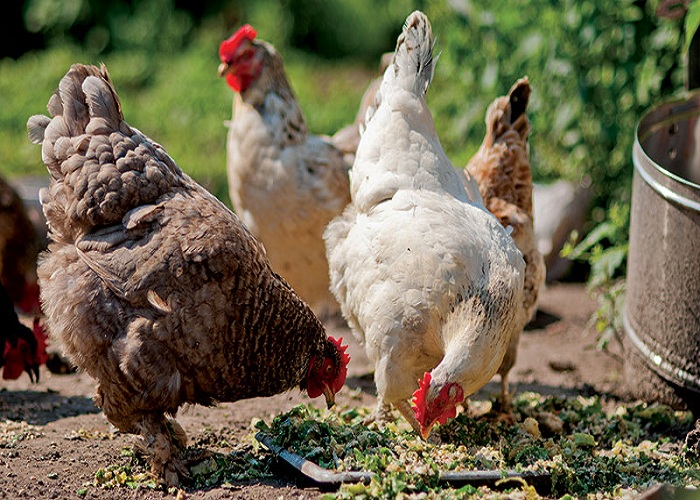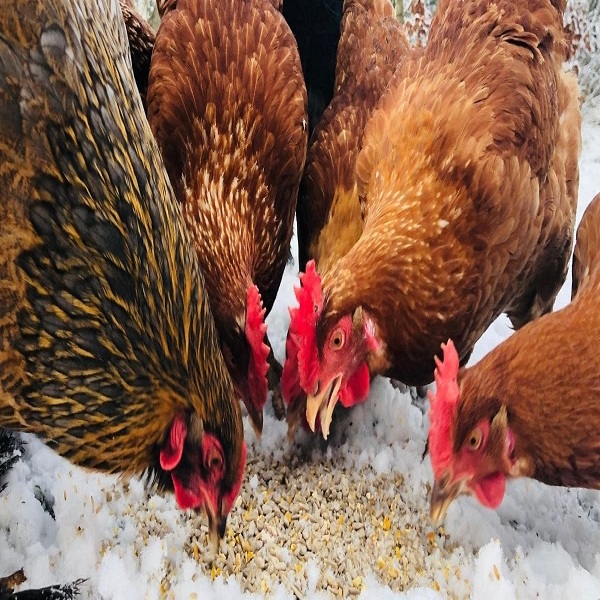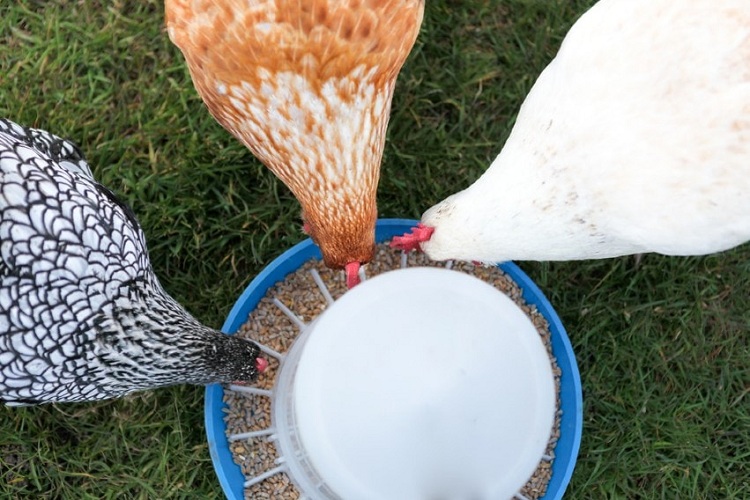Chickens have small stomachs and digestive systems; therefore they prefer frequent, short meals. This means that hens are almost always hungry and obsessed with food.
When hens are deprived of food or water for long periods of time, they cease laying eggs or lay much less frequently. When a flock’s egg production drops, it’s usually because they went hungry for too long.
As obvious as it may be, ensuring your hens always have access to food and water is crucial if you want them to be healthy, happy, and produce eggs.
What to Think About When Deciding on a Chicken Feeder Design
Chicken coops have unique feeding requirements, so it’s important to find a chicken feeder that works for you. It’s important to think about the following before settling on a final design:
The Flock
The size of the chicken feeder you make should reflect the number of birds you keep. The average daily requirement for food for an egg-laying hen is 0.375 cups.
You need to make sure that the feeding container(s) can store adequate food for all of your hens. It needs to be big enough so that feed doesn’t go bad before it’s eaten, but small enough that it won’t be wasted.
It’s also important to consider how the hens get their food. Every chicken should have about two inches of room around it while it eats.
The size and design of the chicken feeder might also be affected by the temperament of your hens. Sometimes the dominant birds will not let the subordinates feed, the nosy hens will knock over the container, and some chickens will just make a mess of it all.
Two or more medium-sized feeders are recommended for a large or disorderly flock to ensure that all chickens get fed.

Location of Chicken Feeder
Is the chicken feeder going inside or outside the coop? Feeder design considerations should take into account the pros and cons of each option.
Rain and snow can ruin a bird’s meal, but indoor feeders prevent that from happening. Mold and spoilage can occur rapidly in damp feed.
An indoor chicken feeder is convenient, but it can be a space hog if your coop is on the smaller side. It also encourages your chickens to spend less time outside, requiring more frequent cleaning of the litter in the coop.
Feeders that can be placed outside of the coop save room inside and allow the chickens to enjoy the outdoors. And the eggs laid by free-range chickens are the healthiest and tastiest option.
In contrast, outdoor feeders must be protected from rain or snow. Also, birds and rats have an easier time getting at chicken feed stored outside, and it can attract predators like raccoons and weasels that prey on poultry.
Some chicken keepers prefer to bring feeders inside for convenience, while others construct an outside feeding area complete with a shaded run. You can also bring the chicken feeders inside at night and then put them back outside in the morning.

Feeder Capacity for Chickens
The amount of care and attention you can devote to your chickens will determine the size of the feeder you need.
It is necessary to replace the hopper of a chicken feeder once every day if it is designed to last for 24 hours. This can be a welcome duty because it allows you to better watch your flock, bond with them, and keep up with the current pecking order drama.
With a higher feeder capacity, you won’t have to spend as much time maintaining it, and you won’t have to worry about the chickens going hungry when you’re away for the weekend. Feeders should have a maximum storage capacity of 10 days at most to prevent food from becoming bad or clogging up.
That being said, here are some great DIY chicken feeder ideas to ensure they never go hungry.
5-Gallon Bucket Chicken Feeder
This automatic feeder can be made for under $5 using just a few PVC elbows, some aluminum rivets, and a 5-gallon bucket.
Make only one for a small flock or several for a bigger one. As an added bonus, it can be moved around the cage with minimal effort.
5-Gallon Bucket Chicken Waterer
It only takes five minutes to convert a 5-gallon bucket into an automatic waterer by drilling some holes in it.
PVC Chicken Feeder
Here are three easy methods for constructing chicken feeders out of PVC pipe and fittings.
No Drill PVC Chicken Feeder
In this DIY project, PVC pipes are simply screwed together to form a J-shape, eliminating the need for drills and other tools. The feeding apertures can be sealed up with a cleanout plug every night for simple maintenance. Keep them standing by zip-tying them to a fence.
Outdoor Chicken Feeder
This automatic feeder design is made entirely of PVC tubing and can be easily assembled with the help of the detailed instructions provided. There’s a lid to keep water out, a spill guard to prevent waste, and a nighttime cap to keep rodents out.
No Waste Chicken Feeder
The “feeding holes” on this mechanical feeder are actually PVC elbows, and the container for the food is a big storage bin. This will reduce waste by making hens stick their heads further down the hole to eat, which is the intended design for deterring scratching.
Treadle Chicken Feeder
Chickens can easily access their food supply by standing on the platform of a treadle feeder, which serves as both the feeding box and the mechanism that opens its top. When the chickens aren’t eating, the food is safe from the elements and pests because the top is closed. Less than $40 is all you need to create this plywood treadle yourself.
Zero Waste Chicken Feeder
This gravity-fed feeder with a big opening around the bottom is another waste-free woodworking project. The trough is protected from precipitation with a little roof.
Hanging Chicken Feeder
This hung chicken feeder requires only a bucket with a handle and a cover that fits snugly, a scrap of untreated wood cut into a square, and a stainless steel eye bolt. Follow these steps to attach a piece of wood to the bottom of a bucket: drill a hole, insert the eye bolt, and screw on the wood. When pecked, this releases the feed.
Trough Chicken Feeder
This straightforward DIY project, in the form of a trough, uses a variety of wood planks to form a rectangular feeding box, able to accommodate a large number of birds at once. Wire mesh placed over the top can separate the space into discrete pecking areas.
Vinyl Gutter Chicken Feeder
Less than $25 is all you need to get started on this simple and effective project that will add roughly 200 inches of feeding space. To prevent feed from overflowing the gutters, you’ll need two 10-foot sections of gutter, 4 concrete blocks, and, if desired, end caps.
Garbage Can Chicken Feeder
A garbage can feeder, which can hold up to 150 pounds of feed, is ideal for herds of chickens or other poultry. Up to four PVC pipe feeding holes can be drilled into the bottom of the bin. Tin cans, which are scratch-proof and produce little waste, can be used to seal off the feeding openings at night. Thanks to the sealed container and the tight top, this configuration can withstand a good amount of precipitation.
Metal Duct Chicken Feeder
This mechanical chicken feeder has a large capacity due to its 7-inch aluminum air ducting. When the chicken enclosure has a low ceiling and is difficult for human-sized bodies to access, this feeder’s design comes in handy. Feed is placed into a container inside the coop, while the input for filling is located outside.
Baby Chick Feeder and Waterer
To make a tiny feeder and waterer for your baby chicks, you can use a clean, empty plastic food container like a peanut butter jar, as shown in this tutorial. Filling the container with feed or water is as simple as cutting holes in the bottom, placing it in a larger dish (in this case a cover), and letting gravity do the rest.
Suspended Baby Chick Feeder
This hanging chick feeder follows suit, being fashioned from recycled plastic bottles. As an example, the bottom of a 2-liter bottle can be used as a tray, while the upper half of a 500-milliliter bottle can be used as a hopper. Cut the smaller bottle open and glue the halves together. When full, it can be strung above the pen to prevent it from being tipped over.

